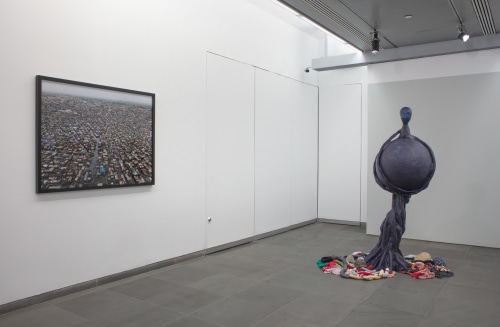
Touch Nature
By Ekin Erkan
February 21, 2024
Stirred by the inauguration of “Land art” with Alan Sonfist's Time Landscape (1965–1978–Present), and spurred by the site-specific public art commissions that soon followed by artists like Robert Smithson, Michael Heizer, and Richard Long, “environmentalist art” has unspooled into myriad directions. The movement’s romantic concerns are presaged by nineteenth-century landscape artists like Caspar David Friedrich, Albert Pinkham Ryder, and the Hudson River School. However, this latter group’s celestial depictions of the landscape conceived of it as an entity to be mastered, attested to by Friedrich’s silhouetted observer in Wanderer above the Sea of Fog (1818), where nature is treated as an awe-inspiring but ultimately conquerable entity. These artists did not and could not attend to the impending environmental catastrophe wrought by a century of ever-exacerbating industrialization and consequent surging global emissions. What Land art and earth art invited was not simply the sanctioning of the wilderness as sculptural material but a sense of exigency. This urgency underwrites much of the artistic endeavors that, today, seek to preserve or analyze nature’s social and environmental history.
Over the last few decades, environmental urgency has been deracinated from exclusively public art settings. “Earth-Body” artists, like Ana Mendieta, have approached nature as an esoteric source of ritual and replenishment. Others, like Julian Charrière, work in a post-humanist tenor, depicting prospective sceneries and artifacts that emerge from omnicide. Touch Nature, at the Austrian Cultural Forum New York, veers closer to the activist approach christened by Sonfist, with the exhibiting Austrian and American contemporary artists engaging issues including global food systems, the spread of epidemics, the legacy of colonialism and crude oil extraction on environments once (and at times still) occupied by Indigenous populations. The variety of media outstrips the variety of themes, allowing the exhibition to narrowly avoid traipsing into redundant re-presentations of an identical phenomenon. In addition to dozens of landscape photographs, prints, and works on canvas—some of which trade in activist aesthetics—the exhibit includes a range of video pieces by Michael Endlicher and Oliver Ressler. These are curated alongside sculptures, assemblages, and installations by Mark Dion, Ursula von Rydingsvard, Luisa Rabbia, Nives Widauer, Martin Schrampf, and Kevin King, among others.
What the exhibition aims to document are contemporary artists’ reactions to a shared, ongoing global ecological crisis and protests against it. Many of the works provide sanguine visions for a possible future marked by a symbiotic relationship between humans and “nature”—which, more often than not, is consonant with natural history and bare wilderness. Admittedly, the strength of the pieces on view and their efficacy is varied. It is difficult for an artist addressing the breadth of this issue not to lapse into one of two twin poles: presenting glimpses into an inexorable future of mankind’s making, blighted nature a byproduct of our everyday consumption habits; or rosy representations of an alternative future, nature marked by reciprocal relations between primordial man and all-powerful nature-cum-goddess. Luisa Rabbia’s ballooning, pregnant androgynous figure in her installation, Worlds (2012), is exemplary of environmental art that diverges from such platitudes. Refugees’ garments lap up the floor as the work speaks to disaster displacement without prescribing individualist solutions. Nature has failed to serve as a protector. Maren Jeleff and Klaus Pichler’s collaboration with microbiologist Martin Kirchmair, "Too close to notice" (2022) are textile prints of velutinous tulip bulbs. The delicate bulbs stand in for a harrowing twenty-first century calamity where patients in a Holland hospital began inexplicably dying and falling ill en masse. The aspergillus fumigatus on the tulip bulbs, which were common in inpatient rooms and are one of the main economic exports in the Netherlands (generating hundreds of millions of dollars in exports), turned out to be the vectors of mortal disease. Nature is here adroitly presented as a protean force, wreaking havoc but ultimately scientifically analyzable and thus apprehensible.
The strongest works in the show do not urge for alternative trajectories but home in on specific environs and histories. They avoid blanket statements and do not yoke moral apothegms. One such work is Edward Burtynsky’s documentary photograph of Lagos, Makoko #1, Lagos, Nigeria (2016). A vista of variegated Makoko houses on stilts dot the metropolis skyline, juxtaposed with high-rises that delineate the city’s distant commercial center. The waterfront’s simple structures function as monuments of both the fishermen who, over a century ago, erected these homes and their descendants, who regularly refurbish them. Nature and man’s relationship is not presented as a reducible phenomena but one which charts a protracted history of workability, disaster and overcoming.
Works like Oliver Ressler’s The path is never the same (2022), however, do ring hollow with platitudes. The artist notes that his film is concerned with how “society’s focus must shift from growth and profit to resource conservation, livelihood preservation, climate justice and global redistribution.” The film documents a community of anarchist activists idealistically living as contemporary transcendentalists, forging makeshift homes in canopies isolated from urban centers. On screen, they vehemently protest and reject the excesses of urbanization and capitalism. Interesting solely as an ethnographic study of the upper-middle class’ naivete, the film ultimately champions an unworkable solution. It is wrapped in an individualistic message of self-indulgence. Mass-scale deindustrialization, de-urbanization, and de-growth policies jettison the already economically tenuous working class, resulting in high unemployment, outmigration, depressed wages, and economic decline. Our climate catastrophe demands public policy that will re-orient manufacturing industries to adopt energy-efficient practices without prompting laborers into economic destitution the likes of which Appalachian coal towns experienced during the early twenty-first century. It is not necessarily the prerogative of artists to advance capacious normative judgments. The best of the environmental art in Touch Nature muses on the human-nature dialectic by unearthing fine-grained histories or phenomena while avoiding such prescriptions.